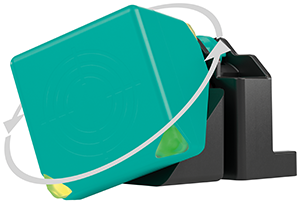
Inductive sensors are still the first choice for detecting metallic objects. However, conventional inductive proximity sensors have one shortcoming in common: if the distance to the damping element increases, the sensor becomes more sensitive to the detection object, and the metal surrounding the installation affects the switching distance.
Active Shielding Technology (AST) from Pepperl+Fuchs solves this problem. Integrated into the VariKont series for the first time, the new technology enables high switching distances – regardless of the installation conditions. This simplifies equipment design and saves time and money.
Sophisticated technology for more flexibility
The installation conditions and surrounding material can influence a proximity sensor’s electromagnetic field. Since the sensor is pre-damped by the installation, this changes the switching distance – and with it the measurement result. To compensate for these external factors, Pepperl+Fuchs has developed a new technology and has integrated it into the VariKont series for the first time. Inductive sensors with AST actively detect the installation situation and maintain a constant switching distance, no matter the installation situation and the surrounding material. They are available in versions with high switching distances of up to 30 mm for flush mounting and 50 mm for non-flush mounting. Both models are easy to install and allow long distances to the detection object. Their adjustable sensor head is equipped with corner LEDs that are visible from any perspective, which enables status checks to be carried out from every angle, regardless of the installation conditions.
Secondary coil compensates for environmental influences
The VariKont and VariKont L2 inductive sensors with high switching distances operate with a primary and secondary coil. As with conventional sensors, the primary coil detects the target. At the same time, the secondary coil measures the environment, including the installation situation and the surrounding material. The information obtained is then used to compensate for environmental influences. This helps achieve the high switching distances described above, which simplifies system planning and optimises the use of mechanical tolerances.

Highlights of the VariKont sensors with AST
• AST ensures high switching distances, no matter the installation situation.
• More flexibility: switching distances up to 30 mm flush and 50 mm non-flush for easier equipment design.
• Convenient status monitoring via high-visibility corner LEDs.
Other benefits include:
• Reliability: no matter the installation situation, sensors achieve high switching distances of 30 mm (flush mount) and 50 mm (non-flush mount). The high level of EMC ensures the sensors are insensitive to external influences and mechanical loads, and can operate in temperatures ranging from -25°C to 70°C.
• Flexible application design: offering the maximum installation flexibility with no effect on the switching distances, AST simplifies equipment design and reduces costs.
• Simplified status monitoring: high visibility corner LEDs enable status checks at any time and from any perspective.
• Fast installation and easy device replacement: both versions of the sensor feature an adjustable head and offer user-friendly installation and replacement. The sensor head can be rotated in five directions for optimal alignment with the target.
• Quality and safety beyond the standard: reliability, process safety and the highest quality standards is what Pepperl+Fuchs proximity sensors have stood for since they first appeared in 1958. As a pioneer in sensor technology, the company is committed to providing its customers with unrivalled quality and service. Based on decades of market experience, the goal is to develop technologies and add new products that are perfectly suited to the requirements of unique applications.
• Long service life: the sensors, with wear-free technology and high EMC, are resistant to external influences and mechanical loads.
Digital communication interfaces
To connect inductive sensors, IO-Link or AS-Interface are often used as digital communication interfaces.
IO-Link
IO-Link is a point-to-point communication system. Sensors with IO-Link (these can be photoelectric sensors, inductive sensors, ultrasonic sensors, etc.) are backward compatible with binary sensors with a switching output. If an IO-Link master is not connected to the sensor, the sensor operates in SIO (standard input and output) mode with a conventional switching output. Integrating an IO-Link sensor into existing systems is thus possible with no restrictions. If the sensor detects a connected IO-Link master when it is switched on, it operates in IO-Link communication mode. In communication mode, the full range of functions of this interface technology is available:
• Parameterisation of sensor functions.
• Reading out of process data.
• Transfer of diagnostic data.
The use of IO-Link also offers the following advantages:
• Reduction in the number of versions – one IO-Link sensor replaces multiple sensors with different output stages.
• Reduction in machine downtime due to differentiated diagnosis.
• Availability of diagnosis information during ongoing operation for preventative servicing.
• Reduction in project planning and installation costs due to standardised interface.
• Simple three-core cable to connect all sensors.
• Combined use of different sensor types: the IO-Link master enables the connection of different sensor types – even the connection of simple binary sensors.
AS-Interface
The actuator-sensor interface (AS-Interface) replaces conventional wiring technology at sensor-actuator level. AS-Interface has firmly established itself as a global standard for cost-effective signal transmission on a single line for energy and signals. It is an open system and therefore found below all common fieldbus systems.
| Tel: | +27 10 430 0250 |
| Email: | [email protected] |
| www: | www.pepperl-fuchs.com/en-za |
| Articles: | More information and articles about Pepperl+Fuchs |

© Technews Publishing (Pty) Ltd | All Rights Reserved